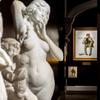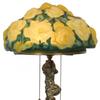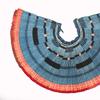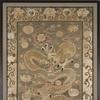The Political History of a Portrait by Lucas Cranach the Elder
- September 06, 2019 14:48
Alongside his contemporaries Hans Holbein the Younger and Albrecht Dürer, Lucas Cranach the Elder is among the most important artists of the German Renaissance. Unlike most art historical figures, his remarkable success and influence in the arts is matched by his impact in the realm of his religious reform. Not only was Cranach instrumental in furthering the artistic excellence of the period, he was also an essential figure in the Protestant Reformation and furthered the cause of Martin Luther. Cranach’s portrait of Frederick the Wise, Elector of Saxony, embodies the political impact of his artistic output.
Frederick III, known as “The Wise,” reigned as Elector of Saxony from 1486 until 1525. It was during this period that Martin Luther famously renounced the Pope and posted his Ninety-Five Theses to the church doors of the Wittenberg Castle in 1517. While in power, Frederick the Wise protected Martin Luther against the Pope and Holy Roman Empire. This was not due to his own religious predilections; at the time, Frederick was Catholic. Rather, the ruler protected Luther under the auspices of religious freedom and fair trial. Gradually, however, Lutheranism would win him over, and the Elector ultimately converted on his deathbed.
As the official painter to Frederick the Wise and a member of the court, Cranach came to know Luther personally and was influenced by his radical new ideas. He would go on to become one of Luther’s greatest proponents and confidantes, lending support through both his art and friendship. His portraits of Luther are among Cranach’s finest work, and his extraordinary woodcut illustrations featured in Luther’s pamphlets helped spread the Reformation across Germany.
Cranach’s portraits of Frederick the Wise follow in these same political and artistic traditions. The portraits were commissioned after Frederick’s death by his nephew Johann the Magnanimous, who inherited the Elector of Saxony title in 1532. This portrait, along with a series of substantially smaller versions also done by Lucas Cranach, served to assert Saxon strength during times of tension between the Saxons and the Habsburgs.
Along with the likeness of Frederick, the work also features laudatory verses on the lower portion of the panel. The poem’s inclusion suggests that the series of 60 commissioned portraits were not merely personal remembrances of the great Saxon leader, but rather tools of propaganda designed as a subtle display of influence and power. These rare portraits were distributed throughout Saxony and gifted to princes who sided with Lutheranism, in effect realigning Frederick’s and the Saxons’ legacy with the spread of this new religion.
This example, painted by Cranach and his workshop around 1535, was almost certainly intended for an important recipient. It is far larger than comparable portraits of Frederick painted by Cranach, measuring over three times the size of an example in the Metropolitan Museum of Art. It is also set apart by its exceptional state of preservation and level of detail. The delicate treatment of the flesh tones and the smallest detail of each hair remains beautifully intact, allowing one to admire the highly developed technique of this German Renaissance master.
The Episcopal Church holds Lucas Cranach the Elder, along with his contemporaries Dürer and Grünewald, in such high regard for their contribution in the early days of the Reformation, that they honor them even today on their Liturgical Calendar. Each year on August 5th, the Church gives thanks for their artistic depictions that “helped the peoples of their age understand the full suffering and glory of thine incarnate Son...”
Click here to learn more about this important portrait.
About M.S. Rau:
M.S. Rau has spent over 100 years earning the trust of discerning collectors worldwide. Located in the heart of New Orleans’ historic French Quarter, our peerless showroom houses one of the world’s most extensive and stunning collections of museum-quality fine art by artists such as Claude Monet and William Bouguereau, 18th- and 19th-century antiques and breathtaking jewelry, including rare colored diamonds.





















